
A dog breed is a particular type of dog that was purposefully bred by humans to perform specific tasks, such as herding, hunting, and guarding. Dogs are the most variable mammal on Earth, with artificial selection producing upward of 360 globally recognized breeds. These breeds possess distinct traits related to morphology, which include body size and shape, tail phenotype, fur type, etc, but are only one species of dog. Their behavioral traits include guarding, herding, and hunting, and personality traits such as hyper-social behavior, boldness, and aggression. Most breeds were derived from small numbers of founders within the last 200 years. As a result of their adaptability to many environments and breedability for human needs, today dogs are the most abundant carnivore species and are dispersed around the world.

The Catahoula Leopard Dog is an American dog breed named after Catahoula Parish, Louisiana. It became the state dog of Louisiana in 1979. It is recognized by the United Kennel Club under the name Louisiana Catahoula Leopard Dog, while the American Kennel Club Foundation Stock Service calls it Catahoula Leopard Dog. Both registries have assigned the breed a herding designation, although it has traditionally been used in hunting feral boars.

The Australian Cattle Dog, or simply Cattle Dog, is a breed of herding dog developed in Australia for droving cattle over long distances across rough terrain. This breed is a medium-sized, short-coated dog that occurs in two main colour forms. It has either red or black hair distributed fairly evenly through a white coat, which gives the appearance of a "red" or "blue" dog.

A working dog is a dog used to perform practical tasks, as opposed to pet or companion dogs.

A herding dog, also known as a stock dog or working dog, is a type of dog that either has been trained in herding livestock or belongs to one of the breeds that were developed for herding. A dog specifically trained to herd sheep is known as a sheep dog or shepherd dog, and one trained to herd cattle is known as a cattle dog or cow dog.

Collies form a distinctive type of herding dogs, including many related landraces and standardized breeds. The type originated in Scotland and Northern England. Collies are medium-sized, fairly lightly-built dogs, with pointed snouts. Many types have a distinctive white color over the shoulders. Collies are very active and agile, and most types of collies have a very strong herding instinct. Collie breeds have spread through many parts of the world, and have diversified into many varieties, sometimes mixed with other dog types.
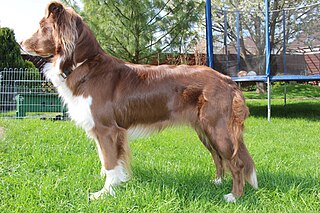
The Australian Shepherd is a breed of herding dog from the United States. The name of the breed is technically a misnomer, as it was developed in California in the 19th century. It is believed to have its origins in sheepdog breeds from northwest Spain, as well as collies imported, alongside sheep, from Australia and New Zealand; the breed reportedly took its name from this trade. Originally used solely as a herding dog, the Australian Shepherd has become one of the most popular companion dog breeds in North America.
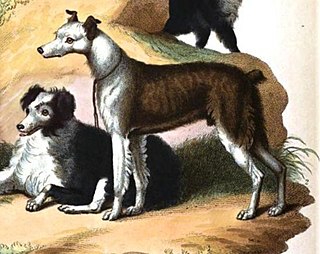
A cur was a dog breed used by cattle drovers in England. The breed is now extinct. In the United States, a short-haired dog used in hunting and herding is called "cur-tailed", or "cur" for short.

The Koolie is an Australian dog breed. The Koolie is a working or herding dog which has existed in Australia since the early 19th century when it was bred from imported British working dogs. Robert Kaleski, in an article on Cattle Dogs in the August 1903 issue of the Agricultural Gazette of New South Wales, describes the "Welsh heeler or merle, erroneously known as the German collie," as a "blue-gray dog about the size and build of a smooth-haired collie, generally with wall eyes." The British background predominated in the dogs that came to be associated with the "German collie" name.

A lurcher is a crossbred dog resulting from mating a greyhound or other sighthound with a dog of another type such as a herding dog or a terrier. The lurcher is not a "breed," but is a generic descriptor of a group of varying dogs. It was for hundreds of years strongly associated with poaching; in modern times, it is kept as a hunting dog or companion dog.
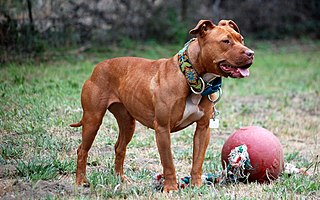
The American Pit Bull Terrier (APBT) is a dog breed recognized by the United Kennel Club (UKC) and the American Dog Breeders Association (ADBA), but not the American Kennel Club (AKC). It is a medium-sized, short-haired dog, of a solid build, whose early ancestors came from England. When compared with the English Staffordshire Bull Terrier, the American Pit Bull Terrier is larger by margins of 6–8 inches (15–20 cm) in height and 25–35 pounds (11–16 kg) in weight. The American Pit Bull Terrier varies in size: males are normally about 18–21 inches (45–53 cm) in height and around 35–60 pounds (15–27 kg) in weight, while females are normally around 17–20 inches (43–50 cm) in height and 30–50 pounds (13–22 kg) in weight.

A feral pig is a domestic pig which has gone feral, meaning it lives in the wild. The term feral pig has also been applied to wild boars, which can interbreed with domestic pigs. They are found mostly in the Americas and Australia. Razorback and wild hog are sometimes used in the United States refer to feral pigs or boar–pig hybrids.

The Pont-Audemer Spaniel or Epagneul Pont-Audemer is a rare breed of French gundog. It originated in the nineteenth century from different breeds of water spaniels, and took more of a setter role in hunting than that of a traditional spaniel. Following the Second World War, the breed's numbers dropped so low that the breed club decided to allow cross breeding with other breeds because of fears of the existing stock becoming overly inbred. In 1980, the breed club was merged with that of the Picardy Spaniel.

The Central Asian Shepherd Dog, also known as the Alabay, Alabai and Turkmen Wolf-Hound, is a livestock guardian dog breed. Traditionally, the breed was used for guarding sheep and goat herds, as well as to protect and for guard duty. In 1990, the State Agroindustrial Committee of Turkmenistan approved the standard of the Turkmen Wolf-Hound dog breed.
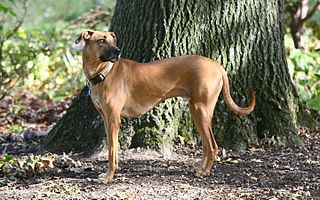
The Black Mouth Cur, also known as the Southern Cur, Southern Black Mouth Cur and the Yellow Black Mouth Cur, is a medium to large sized breed of cur-type dog from the United States. Originating in the south of the country, the breed is a popular hunting companion used to hunt a large variety of game.

Laikas are aboriginal spitz from Northern Russia, especially Siberia but also sometimes expanded to include Nordic hunting breeds. Laika breeds are primitive dogs who flourish with minimal care even in hostile weather. Generally, laika breeds are expected to be versatile hunting dogs, capable of hunting game of a variety of sizes by treeing small game, pointing and baying larger game and working as teams to corner bear and boar. However a few laikas have specialized as herding or sled dogs.
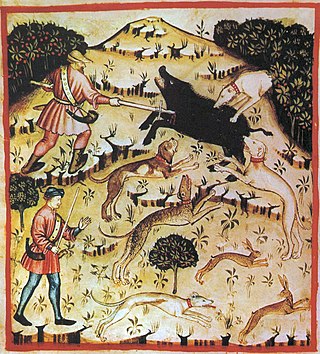
Boar hunting is the practice of hunting wild boar, feral pigs, warthogs, and peccaries. Boar hunting was historically a dangerous exercise due to the tusked animal's ambush tactics as well as its thick hide and dense bones rendering them difficult to kill with premodern weapons.
Uncle Earl's Hog Dog Trials is an annual Hog Dog Baying Event held in the third weekend of March in Winnfield, Winn Parish, Louisiana at the Winn Parish Fair Grounds involving boars and various breeds of bay dogs, including Catahoula Leopard Dogs, Blackmouth Cur, Blue Lacy, and others.

Dog types are broad categories of domestic dogs based on form, function, or style of work, lineage, or appearance. Some may be locally adapted dog types that may have the visual characteristics of a modern purebred dog. In contrast, modern dog breeds strictly adhere to long-established breed standards,[note 1] that began with documented foundation breeding stock sharing a common set of inheritable characteristics, developed by long-established, reputable kennel clubs that recognize the dog as a purebred.

The Yakutian Laika is an ancient working dog breed that originated in the Arctic seashore of the Sakha (Yakutia) Republic. Yakutian Laikas are multipurpose laikas, with many lineages able to herd reindeer, hunt game and/or pull a sled. They are registered with the Russian Kennel Club, the FCI and the AKC's Foundation Stock Service in 2017.





















